1月 29, 2020 / 湖南省人民病院, 等. / 酸化医学と細胞の寿命
文/呉廷耀
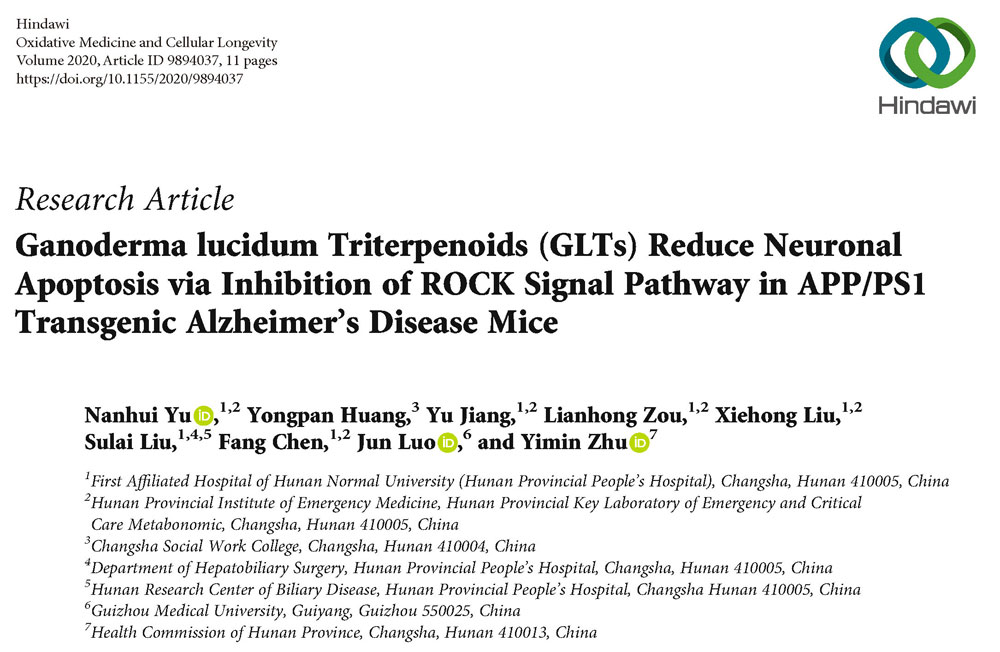
湖南省人民病院と湖南省救急救命重点研究所メタボノミクスが「酸化医学と細胞寿命」に発表した研究では、次のことが指摘されている。マンネンタケ トリテルペノイド(GLT) 脳の神経細胞を保護し、アルツハイマー病によって引き起こされる認知障害を軽減することができます (広告) 抗アポトーシスなどのメカニズムを通じて, 抗酸化, 抗神経原線維変化.
マンネンタケ トリテルペノイドはアルツハイマー病患者の認知機能低下を遅らせる.
初め, 研究者に餌を与えたマンネンタケ トリテルペノイド (GLT) アルツハイマー病に (広告) 初期症状を発症したマウス。 60日後, 彼らはモリス水迷路を使ってマウスの認知能力をテストしました (MWM).
もともと水を嫌い、常に水を避ける場所を探しているネズミの特性を利用, 研究者らはモリス水迷路を実施した, これは、大きな円形のプールに休憩台を設置し、マウスが泳ぐ距離と休憩台を見つけるのに費やした時間を計算し、マウスの認知能力を判断する指標とするものです。. ネズミが休憩台を見つけられなかった場合 (2分以内に), 研究者たちはマウスをプラットフォームまで誘導するのを手伝います.
入水開始地点は毎回異なりますが, 正常なマウスは、日々の経験を通じて、休息台をすぐに見つけることができます。. このような実験は1日1回、合計9日間実施されました。. すべてのスコアの平均を計算する, 研究者らは、ADマウスが (ADグループ) 通常のマウスの2倍の時間を過ごすか、4分の3長く泳ぐ必要がある (対照群) 休憩台を見つけるために, これはADマウスの脳の認知機能が著しく低下していることを示している.
しかし, 高用量を与えられたADマウス (1.41日あたりg/kg) の GLT は、正常なマウスと AD マウスとほぼ同じ時間と泳ぎ距離で休息台を見つけました。 (西洋医学対照群) 毎日ドネペジルを与えられている(図1~2).
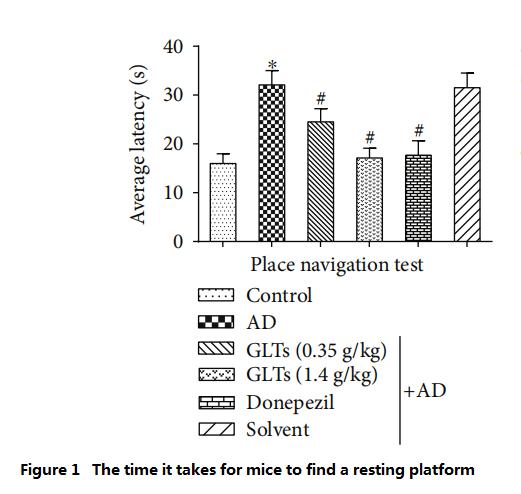
(必要な時間が短いほど, 認知能力が高いほど)
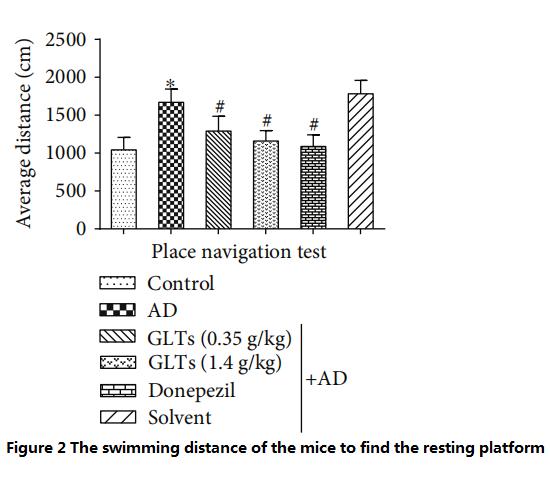
(必要な距離が短いほど, 認知能力が高いほど)
上記実験終了翌日, 研究者らはプール内の休憩台を撤去し、マウスを水の中に2分間入れた。.
過去9日間の経験により, 正常なマウスはプラットフォームの元の位置を記憶しており、「消えたプラットフォーム」を探すために元の場所の周りを泳ぐ時間を多く費やしましたが、アルツハイマー病マウスは目的もなく泳ぎました。.
対照的に, GLTによって保護されたアルツハイマー病マウスは、低用量でも正常なマウスと同様に行動した (0.35 1日あたりg/kg) または高用量 (1.4 1日あたりg/kg) 西洋薬を与えたMDマウスとほぼ同じスコアでした (数字 3 に 4).
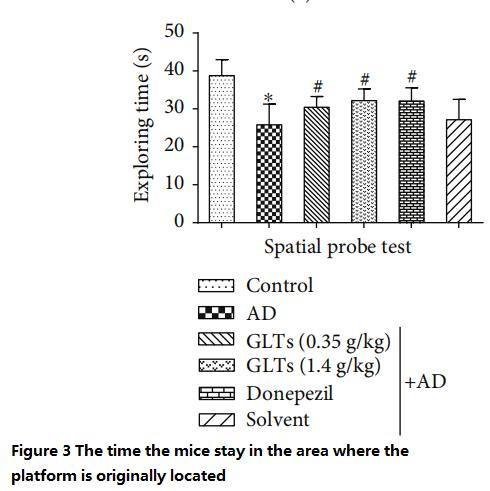
(滞在期間が長ければ長いほど, 認知能力が高いほど)
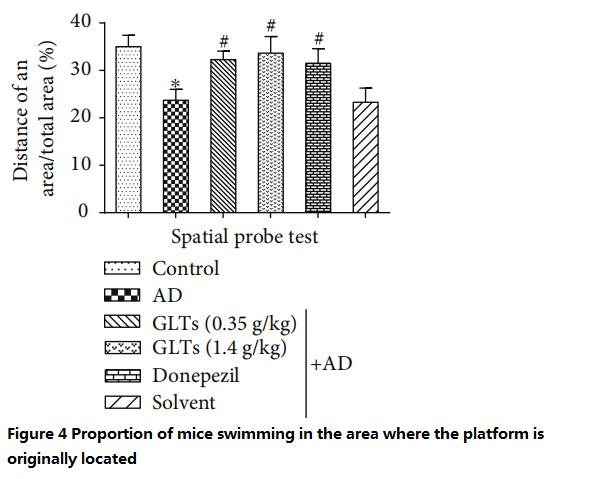
(割合が高いほど, 認知能力が高いほど)
マンネンタケ トリテルペノイドは神経細胞の完全性を維持します.
学習能力と記憶能力の低下は、最も初期の認知機能低下です。 (障害) アルツハイマー病患者において, この機能を担当する神経細胞は海馬回にあります。. したがって, 研究者が上記の実験を完了した後, 彼らはさらなる検査のためにマウスの脳を解剖した.
その結果、正常なマウスの海馬回の神経細胞はきちんと配列されていることがわかりました。, サイズが均一である, 見た目が規則正しい, 細胞膜と核は明確に区別されています; ADマウスの海馬回の神経細胞は無秩序に配置されている, 大きさが違う, 見た目が不規則, 数が大幅に減りました, そしてその構造は明らかに損傷しています.
しかし, この状況は霊芝トリテルペノイドを摂取したADマウスでは現れなかった. 海馬回の神経細胞は依然として高度な完全性を維持していました, 明らかな細胞壊死はありませんでした, それを示しているマンネンタケ トリテルペノイドには海馬回に対する保護効果がありました ( 形 5).
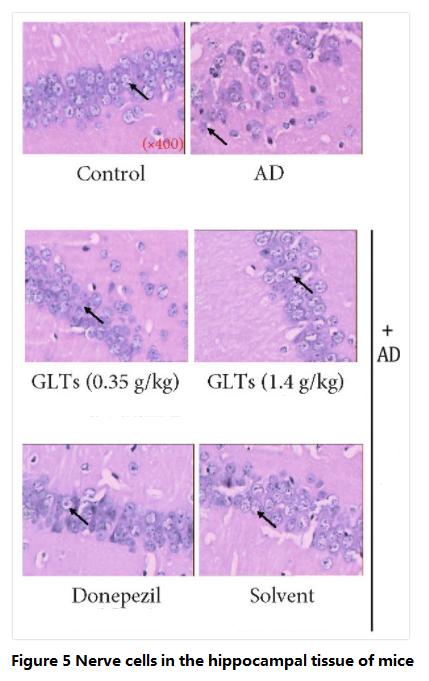
マンネンタケ トリテルペノイドは神経原線維変化を軽減します.
同時に, 研究者らはまた、大脳皮質における神経原線維変化の数が、 (長期記憶を保存する) AD マウスの海馬回組織は、マンネンタケ トリテルペノイドは未治療のADマウスよりも有意に低かった (形 6).
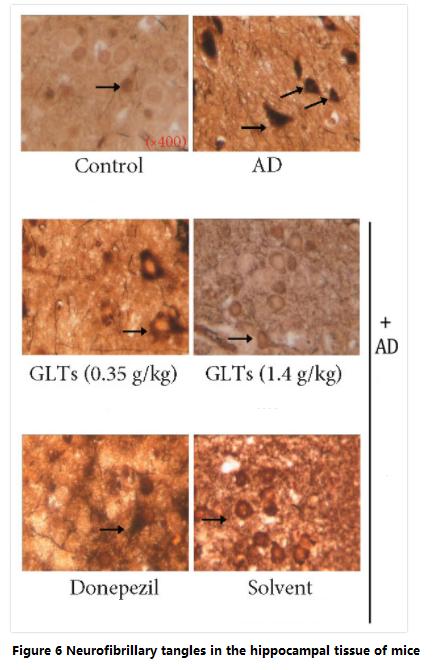
神経原線維変化はアルツハイマー病の主な症状の 1 つです. 細胞外で発生するアミロイド沈着とは異なります。, 「タウタンパク質」の変異により神経細胞内で神経原線維変化が起こる.
通常の状況では, タウタンパク質は細胞骨格に結合します (微小管) 細胞骨格の形成と安定性を助ける. しかし, アルツハイマー病患者の脳内のタウタンパク質は突然変異し、細胞骨格に結合できなくなります. 結果として, タウタンパク質はクラスターに凝集して、いわゆる「神経原線維変化」を形成します。, 細胞内に蓄積して細胞の機能を阻害する. taoタンパク質が欠損した細胞骨格は徐々に歪み、崩壊していきます。, 細胞死につながる.
神経原線維変化の数はアルツハイマー病の悪化の程度を反映する. したがって, 霊芝トリテルペノイドは神経原線維変化の形成を阻害することができます, これは重要なメカニズムの 1 つであるはずです。マンネンタケ トリテルペノイドはアルツハイマー病の認知機能低下を遅らせる.
マンネンタケ トリテルペノイドは神経細胞のアポトーシスを軽減します.
β-アミロイドの沈着または神経原線維変化のいずれかが細胞の自殺プログラムを開始し、神経細胞のアポトーシスを促進します。. より多くの神経細胞が死滅するため、, さらに多くの機能が失われます, アルツハイマー病による認知機能の低下がさらに深刻になる.
実験用マウスの各グループの海馬回組織の解析から, ADマウスの神経細胞の死亡率は、同年齢の正常なマウスの4倍以上であることがわかります。; 高用量ではあるが霊芝明晰 トリテルペノイドは神経細胞の異常なアポトーシスを完全に防ぐことはできません, 彼らはダメージを半減することができた, その効果は西洋医学と同等です (形 7).
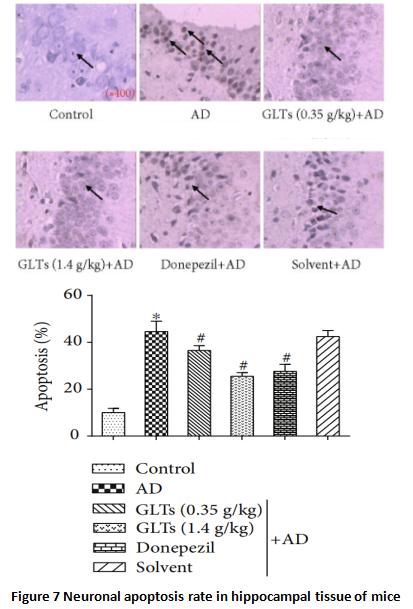
研究者らはさらに分析し、アルツハイマー病ではマウスが次のような方法で維持されていることを発見した。マンネンタケ トリテルペノイド, 脳神経細胞は、β-アミロイドタンパク質によって引き起こされる酸化損傷と戦う強力な抗酸化メカニズムを備えており、細胞のアポトーシスメカニズムは容易には活性化されません。. 言い換えると, 霊芝トリテルペンは脳神経細胞のストレス耐性を強化します, 過酷な環境でより生存し活動できるようにする.
マンネンタケ 多糖類も有用です.
上記の研究結果は次のことを示していますマンネンタケ トリテルペノイド, 食道を通って消化管に入った後, 抗酸化作用によりアルツハイマー病の進行を遅らせることができる, 抗アポトーシス, 抗神経原線維変化.
実際には, の影響マンネンタケ 多糖類はマンネンタケのトリテルペノイドよりも弱くありません. で 2017, 同済大学と中国科学院が共同で「幹細胞レポート」に発表した研究では、幹細胞の長期維持が証明された。マンネンタケ 水抽出物やマンネンタケ 多糖類はADマウスの脳のβ-アミロイド沈着を減少させることができる, 海馬回の神経前駆細胞の増殖を助け、学習と記憶の低下を遅らせます。. (詳細はこちら, 見る: マンネンタケ多糖体s アルツハイマー病による認知機能低下を軽減する)
マンネンタケ トリテルペノイドとマンネンタケ 多糖類は、アルツハイマー病の脳を保護する上でさまざまな効果があるようです。両者の複合効果でアルツハイマー病の進行を遅らせることができるか?
アルツハイマー病が発症すると, それを逆転させるのは難しい. しかし, もっと認知能力を維持できれば, 学習や記憶も含めて, 私たちの限られた人生の中で, アルツハイマー病を改善するチャンスがあるかもしれない.
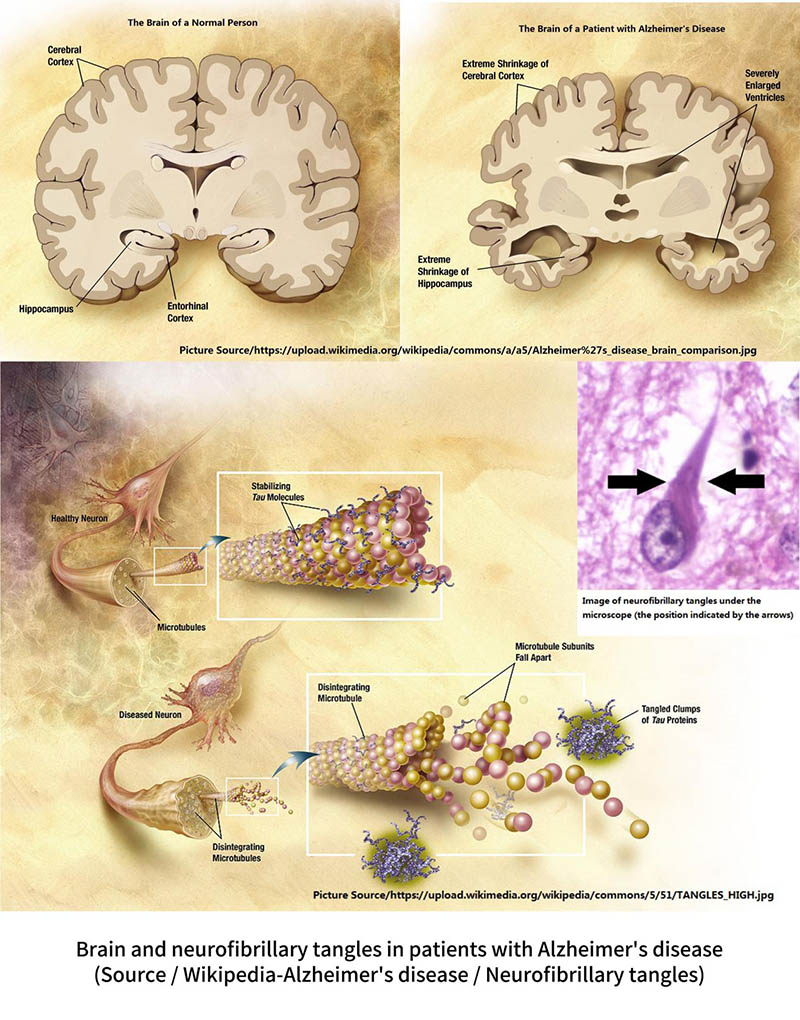
ソース
1. ユン, 他. マンネンタケ トリテルペノイド (GLT) APP/PS1 トランスジェニックアルツハイマー病マウスにおける ROCK シグナル経路の阻害を介して神経細胞のアポトーシスを軽減する. 酸化物とセル Longev. 2020; 2020: 9894037.
2. 黄 S, 他. 由来の多糖類 マンネンタケ アルツハイマー病のマウスモデルにおける認知機能と神経前駆細胞の増殖を促進する. 幹細胞レポート. 2017 1月 10;8(1):84-94. 土肥: 10.1016/j.stemcr.2016.12.007.
終わり
著者について/Mさん. 呉廷耀
呉廷耀氏は直接報告しているマンネンタケ それ以来の情報 1999. 彼女はの著者です霊芝による治癒 (4月に人民医学出版社に出版 2017).
★この記事は著者の独占的な許可を得て掲載されています
★上記作品は転載禁止です, 著者の許可なく抜粋または他の方法で使用される
★上記記載事項に違反した場合, 著者は関連する法的責任を追及します
★この記事の原文はWu Tingyaoが中国語で執筆し、Alfred Liuが英語に翻訳しました。. 翻訳に齟齬があった場合 (英語) そしてオリジナル (中国語), 本来の中国人が勝つだろう. 読者に質問がある場合, 原作者に連絡してください, MS. 呉廷耀.



